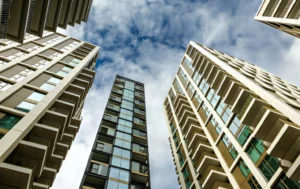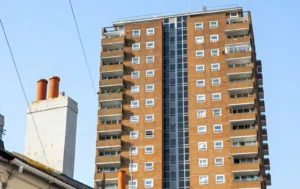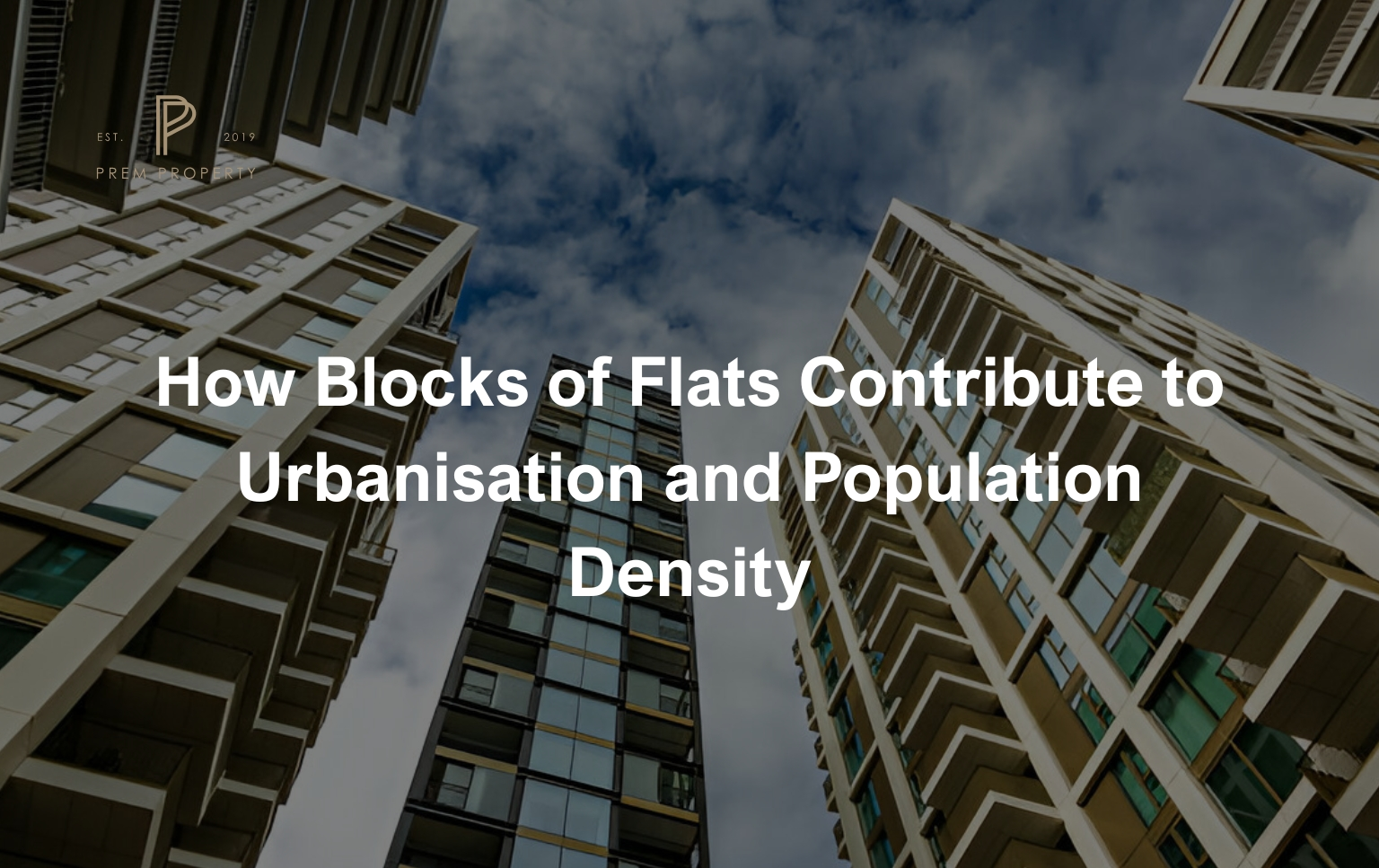The rapid transformation of Britain’s urban landscape tells a compelling story of how blocks of flats have become instrumental in shaping modern cities. As urban populations continue to swell, these vertical communities have emerged as crucial solutions to accommodation challenges whilst fundamentally altering the character of our towns and cities.
The Urban Housing Revolution
Britain’s housing crisis has reached unprecedented levels, with demand far outstripping supply in major metropolitan areas. According to the latest government data, 15,682 homes started on site in 2024-25, representing a 19% increase compared to the previous year, with flat developments forming a substantial proportion of new builds. Consequently, blocks of flats have evolved from basic accommodation into sophisticated urban solutions that maximise land use efficiency. Rather than sprawling outwards, cities are growing upwards, creating dense residential clusters that house thousands of residents within relatively small footprints.
This vertical expansion has transformed traditional neighbourhood dynamics. Where once terraced houses dominated British streets, towering residential blocks now punctuate skylines from Manchester to Brighton. Moreover, these developments have catalysed broader urban regeneration projects, breathing new life into previously neglected areas.
Maximising Land Efficiency Through Vertical Living
The mathematical logic behind flat developments is compelling. A single block occupying the same ground space as four detached houses can accommodate fifty or more families. This efficiency becomes particularly crucial in cities where available land commands premium prices and planning restrictions limit horizontal expansion. Current UK statistics reveal that the nation has a population density of 279 people per square kilometre, with England significantly more dense than other regions, highlighting the critical need for efficient housing solutions.
Furthermore, blocks of flats allow developers to utilise previously unsuitable sites. Former industrial zones, abandoned car parks, and narrow strips of urban land can be transformed into thriving residential communities. With 28.36 million residential properties across the UK and nearly 15% concentrated in London alone, this adaptive reuse not only increases housing stock but also contributes to urban renewal and environmental sustainability.
The economic implications extend beyond mere numbers. When more people live within smaller geographic areas, the cost per resident for essential infrastructure decreases significantly. Roads, sewerage systems, and utility networks serve larger populations more efficiently, creating economies of scale that benefit both residents and local authorities.
Property Investment and Guaranteed Rent Solutions
The proliferation of blocks of flats has created substantial opportunities for property investors seeking stable returns in urban markets. Modern flat developments offer attractive investment prospects through various ownership models, from traditional buy-to-let arrangements to more sophisticated investment structures.
Guaranteed Rent Solutions have emerged as particularly valuable services for property investors in the flat market. These arrangements provide landlords with assured monthly rental income, typically ranging from one to five years, regardless of vacancy periods or tenant issues. Property management companies specialising in guaranteed rent take full responsibility for finding tenants, handling maintenance and managing day-to-day operations, offering investors peace of mind and predictable returns.
Companies like Prem Property exemplify the modern guaranteed rent solution provider, offering comprehensive services that address the specific challenges of flat investments in urban markets. These specialist providers typically offer:
- Guaranteed monthly rental payments for extended periods
- Complete tenant sourcing and placement services
- Professional property management and maintenance coordination
- Full compliance with tenancy regulations and legal requirements
- Regular property inspections and condition reporting
- 24/7 emergency response and tenant support services
The guaranteed rent model proves especially beneficial for flat investments because:
- High tenant turnover common in urban flat complexes can disrupt rental income
- Professional management ensures compliance with increasingly complex tenancy regulations
- Investors can leverage guaranteed income for mortgage applications and financial planning
- Risk transfer allows investors to focus on portfolio growth rather than operational management
- Specialist providers understand the unique challenges of flat-based developments

Reshaping Population Distribution Patterns
Blocks of flats have fundamentally altered how populations distribute themselves across urban areas. Previously, families seeking affordable housing often relocated to suburban areas, creating lengthy commutes and urban sprawl. However, modern flat developments increasingly offer city-centre living options that keep residents close to employment opportunities and cultural amenities. With 84.5% of the UK population now classified as urban, representing 58.8 million people in 2025, the demand for efficient urban housing solutions has never been greater.
This shift has created more balanced urban ecosystems. Young professionals, aged residents downsizing, and growing families now coexist within the same developments, fostering diverse communities that were traditionally segregated by housing type and location. Additionally, these mixed demographics contribute to vibrant local economies, supporting everything from corner shops to specialist services.
The impact on transport systems has been equally significant. When thousands of residents live within walking distance of employment centres, public transport usage increases whilst car dependency decreases. This transformation supports sustainable urban development goals and reduces environmental impacts associated with suburban commuting patterns.
Infrastructure Development and Urban Services
The concentration of residents in blocks of flats necessitates sophisticated infrastructure planning. Water supply systems must accommodate peak usage patterns, whilst waste management requires innovative solutions for high-density living. Consequently, cities have developed more efficient service delivery models that benefit entire urban areas.
Educational facilities represent another crucial consideration. Large residential developments generate substantial demand for school places, prompting local authorities to invest in new educational infrastructure. These improvements often extend beyond immediate residents, enhancing educational opportunities for broader communities.
Healthcare provision has similarly adapted to serve concentrated populations. Medical centres, pharmacies and specialist services cluster around major residential developments, creating healthcare hubs that serve thousands of residents within convenient distances. This accessibility particularly benefits aged residents and families with young children.
Economic Drivers of Urban Growth
The construction and management of blocks of flats generate substantial economic activity within urban areas. Building projects employ hundreds of workers, from architects and engineers to construction crews and interior designers. Subsequently, ongoing property management creates permanent employment opportunities that support local economies.
The property investment sector surrounding flat developments has become increasingly sophisticated, supporting numerous specialist businesses:
- Guaranteed rent solution providers like Prem Property offering comprehensive landlord services
- Maintenance and refurbishment contractors serving multiple developments
- Financial services providers offering buy-to-let mortgages and investment advice
- Legal services specialising in leasehold and property investment matters
- Technology platforms supporting property management and tenant communication
Retail and hospitality sectors particularly benefit from increased population density. Ground-floor commercial spaces in residential blocks often house essential services such as convenience stores, cafes and professional services. This commercial integration creates walkable communities where residents can access daily necessities without travelling significant distances.
Property values in areas with successful flat developments often appreciate more rapidly than traditional housing markets. This growth reflects increased demand for urban living and improved local amenities. However, recent data shows that housing affordability remains challenging, with only 9% of local authorities in England and Wales deemed affordable in 2024, where homes cost less than five times workers’ earnings on average. This statistic underscores both the economic importance of efficient housing solutions and the ongoing affordability challenges facing urban residents.
Social and Cultural Transformation
Living in blocks of flats has reshaped social interactions and community formation. Shared spaces such as gardens, gyms, and community rooms facilitate connections between neighbours who might otherwise remain strangers. These interactions contribute to stronger community bonds and mutual support networks.
Cultural diversity flourishes within these developments. International residents, students, and workers from various backgrounds create cosmopolitan environments that enrich local communities. This diversity supports multicultural businesses, restaurants, and services that enhance urban cultural offerings.
Social housing continues to play a significant role, with approximately 17% of UK households living in council housing as of 2024, demonstrating the ongoing importance of public sector involvement in providing affordable urban accommodation. Additionally, amongst the 4.8 million leasehold properties in the UK, 30% or 1.4 million are concentrated in London, illustrating the capital’s reliance on flat-based housing solutions.
Nevertheless, concerns about social isolation persist. Some residents struggle with the transition from traditional housing to flat living, particularly aged individuals who may find it challenging to adapt to vertical communities. Addressing these concerns requires thoughtful design and community engagement programmes.
Property Investment Opportunities and Market Dynamics
The flat market presents diverse investment opportunities across different price points and target demographics. Guaranteed rent solutions provided by companies like Prem Property have become increasingly popular among investors seeking passive income streams, particularly in developments targeting:
- Young professionals in city centres requiring furnished accommodation
- International workers and temporary residents
- Families seeking affordable urban living options
Guaranteed rent providers serve various market segments, from standard rental properties to higher-end developments, adapting their services to meet different investor needs and tenant expectations. The success of these arrangements depends on:
- Strategic location selection near transport links and employment centres
- Understanding of local rental markets and tenant demand patterns
- Professional property presentation and marketing
- Efficient maintenance and tenant management systems
- Compliance with evolving tenancy regulations and safety requirements
The guaranteed rent model has proven particularly effective in flat developments because it addresses the unique challenges of urban rental properties while providing investors with predictable returns and professional management expertise.

Environmental Implications and Sustainability
Modern blocks of flats increasingly incorporate environmental considerations into their design and operation. Energy-efficient systems, renewable energy sources, and sustainable building materials reduce environmental impacts per resident compared to traditional housing.
The concentration of residents also supports more efficient public transport systems and reduces urban sprawl. When people live in dense developments, the environmental cost of providing services and infrastructure decreases significantly. This efficiency contributes to broader sustainability goals and climate change mitigation efforts.
Green spaces within and around flat developments have evolved beyond simple landscaping. Roof gardens, communal growing areas, and wildlife corridors create urban oases that support biodiversity whilst providing residents with access to nature.
Future Prospects and Urban Planning
The continued growth of blocks of flats will inevitably shape Britain’s urban future. Planning authorities increasingly recognise these developments as essential components of sustainable city growth. Strategic placement of residential blocks near transport hubs and employment centres will likely become standard practice.
Smart building technologies promise to make flat living even more attractive and efficient. Integrated systems for energy management, security, and communication will enhance resident experiences whilst reducing operational costs. These innovations will likely accelerate the adoption of vertical living solutions.
The property investment sector will continue evolving to serve this growing market. Guaranteed rent providers like Prem Property are expanding their services to include portfolio management and development consulting, incorporating technology-driven solutions to enhance operational efficiency and investor returns while maintaining focus on tenant satisfaction and property care.
The Transformation of Britain’s Urban Landscape
Blocks of flats have become indispensable elements of modern urban development, addressing housing shortages whilst fundamentally reshaping how cities grow and function. Through efficient land use, infrastructure optimisation, and community creation, these developments contribute significantly to urbanisation and population density management.
The supporting ecosystem of property investment services, including guaranteed rent solution providers like Prem Property, ensures these developments remain viable and attractive to both residents and investors. This professional infrastructure supports continued growth and improvement in flat-based urban living.
As Britain’s cities continue expanding, the role of blocks of flats will likely become even more crucial. Successful integration of these developments requires careful planning, community engagement, and ongoing investment in supporting infrastructure. When implemented thoughtfully, blocks of flats create vibrant, sustainable communities that enhance urban living for thousands of residents whilst contributing to the broader goals of sustainable city development and providing attractive investment opportunities for property investors seeking stable returns in dynamic urban markets.

